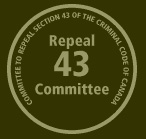Assaulting children to discipline them
The "Spanking" issue heard by the Supreme Court of Canada
Chief Justice of the Supreme Court of Canada doesn't support children's rights
"An illustration of the lack of appreciation of the importance of Canada's commitment to children's rights was seen in the comments made by Chief Justice McLachlin during the Supreme Court deliberations on the constitutionality of section 43 of the Criminal Code. She not only disregarded the consistent recommendations of the UN Committee on the Rights of the Child, but also went on to say that the best interest of the child "is not vital or fundamental to our social notion of justice."
- Professor Katherine Covell, CBU Children's Right Centre (Cape Breton University) testimony before the Senate Standing Committee on Human Rights Feb. 7, 2005 Read More ..
From the website of the Justice Department - Canada (Attorney General of Canada)
Section 43 of the Criminal Code (Corporal Punishment)
The Canadian Foundation for Children, Youth and the Law v. The Attorney General of Canada
On January 30, 2004, the Supreme Court of Canada released its decision in the case of Canadian Foundation for Children, Youth and the Law v. The Attorney General in Right of Canada, which concerns the use of force by parents and teachers to "correct" a child. This fact sheet provides a summary of the case.
Issue Before the Supreme Court of Canada
The issue before the Supreme Court of Canada was whether s.43 of the Criminal Code of Canada is unconstitutional. Section 43 provides that a parent, teacher or person acting in the place of a parent is justified in using force to correct a child that is under his or her care provided that the force used is reasonable in all of the circumstances.
Decision
The Supreme Court of Canada decided that section 43 of the Criminal Code is constitutional; it found that section 43 does not violate a child's rights to security of the person and equality, and is not cruel and unusual punishment. more specifically, the Supreme Court held that section 43 ensures that the criminal law applies to any use of force that harms a child, but does not apply where the use of force is part of a genuine effort to educate the child, poses no reasonable risk of harm that is more than transitory and trifling, and is reasonable under the circumstances.
Position of the Parties
The Canadian Foundation for Children, Youth and the Law, argued that section 43 violates children's Charter rights to security of the person, equality and that section 43 constituted cruel and unusual punishment. The Attorney General of Canada argued that section 43 reflects a fair balance between the interests of children, parents and Canadian society. Although the federal government does not condone the physical discipline of children, neither does it support the criminalization of parents for disciplinary conduct which is undertaken in a reasonable way and takes into account the needs and best interests of children.
History of the Case
In November 1998, the Canadian Foundation for Children, Youth and the Law sought a declaration in Ontario that section 43 violates sections 7 (security of the person), 12 (cruel and unusual punishment), and 15 (equality) of the Canadian Charter of Rights and Freedoms and that it conflicts with Canada's obligations under the United Nations Convention on the Rights of the Child. Section 43 is a limited defence; it provides that a parent, teacher or person acting in the place of a parent is justified in using force to correct a child that is under his or her care, provided that the force used is reasonable in all the circumstances.
The federal government defended against the Charter challenge and was supported by the Canadian Teachers Federation and the Coalition for Family Autonomy (Focus on the Family, the Canadian Family Action Coalition, the Home School Legal Defence Association of Canada, and REAL Women of Canada). The Canadian Foundations position was supported by the Ontario Association of Children's Aid Societies.
In its decision of July 5, 2000, the Ontario Superior Court of Justice upheld the constitutionality of section 43 and found that it was consistent with Canada's obligations under the United Nations Convention on the Rights of the Child. It held that the current test to determine the applicability of section 43 reflects a reasonable balance of the Charter interests of children, parents and Canadian society. This test involves an examination of a variety of factors including the age and character of the child, the nature of the child's behaviour calling for correction, the degree and gravity of the punishment, and the circumstances under which the force was applied. These factors are assessed against the contemporary Canadian community's standard of reasonableness and not against the rules or practices of an individual family. The court provided additional guidelines, based on expert evidence led in the case, to aid in interpreting and applying section 43 in accordance with the Charter. These guidelines relate to the corporal punishment of very young children and teenagers, the use of objects in corporal punishment, injury, and effective alternatives to corporal punishment, among others.
On January 15, 2002, the Ontario Court of Appeal upheld the lower courts decision and dismissed the appeal. This decision was appealed to the Supreme Court of Canada, which heard the appeal on June 6, 2003 and reserved judgment. The judgment was provided on January 30, 2004.
The Supreme Court of Canada
Judgment
January 30, 2004
The Supreme Court of Canada Reasons for Judgment
CORPORAL PUNISHMENT: Towards Constructive Child Discipline
Report
During the Commission on Human Rights, UNESCO launched a new report entitled "Eliminating Corporal Punishment - The Way Forward to Constructive Child Discipline". The United Nations Committee on the Rights of the Child has consistently recommended States Parties to the Convention on the Rights of the Child to prohibit corporal punishment and other forms of violence against children in institutions, in schools, and in the homes. The past 25 years have shown that the elimination of corporal punishment is not easy to achieve.
To discipline or punish through physical harm is clearly a violation of the most basic of human rights. Research on corporal punishment has found it to be counterproductive and relatively ineffective, as well as dangerous and harmful to physical, psychological and social well being. While many States have developed child protection laws and systems violence still continues to be inflicted upon children.
This UNESCO publication provides a comprehensive approach, including the main steps to be considered in the process of eliminating corporal punishment, and provides tools to accomplish this goal. It shows the human rights imperative and describes several aspects of the negative consequences and implications that are caused. It details practical steps for more constructive and effective child discipline practices, and ongoing supports for long-term change.
An international panel of experts presents descriptions of some of the constructive discipline orientations and practices known to be applied in Asia, Africa, Europe, the Middle East, and South America. They include: involving learners and their parents in decisions about codes of conduct and associated practices; providing guidance in the selection of positive models in peers and classmates; family meetings and inter-generational dialogue; rendering services to the community to rectify rule infractions; and exploring ethical-moral meanings and implications in current events. Additionally, two experts on Indigenous peoples provide descriptions of constructive child rearing and discipline orientations and related practices for peoples they know well.
For more information, contact:
UNESCO
7 Place de Fontenoy, 75352 Paris 07 SP, France
Tel: + 33 1 45 680 686; Fax: + 33 1 45 685 626
Website: www.unesco.org
U.N. Committee of the Rights of the Child 42nd Session ( June 2006 )
General Comment No. 8: The right of the child to protection from corporal punishment and other cruel or degrading forms of punishment

Global Initiative to
End All corporal Punishment of Children
Launched in April 2001, the Global Initiative to End All Corporal Punishment of Children aims to speed the end of corporal punishment of children across the world.
The Global Initiative aims to:
-
form a strong alliance of human rights agencies, key individuals and non-governmental organisations against corporal punishment;
-
make corporal punishment of children visible by building a global map of its prevalence and legality, ensuring that children's views are heard and charting progress towards ending it;
-
lobby state governments systematically to ban all forms of corporal punishment and to develop public education programmes;
-
provide detailed technical assistance to support states with these reforms.
"A child shall be brought up in the spirit of understanding, security and love. He shall not be subdued, corporally punished or otherwise humiliated. His growth towards independence, responsibility and adulthood shall be encourage, supported and assisted." - Finland's Child Custody and Right of Access Act 1983
www.endcorporalpunishment.org
Landmark European human rights ruling on equal protection
June 2005
Responding to human rights complaints brought against five countries, the European Committee of Social Rights has confirmed (June 2005) that supreme court judgments in Italy and Portugal do prohibit all corporal punishment of children. This means that more than a third (16 of 46) member states of the Council of Europe now give children equal protection under their assault laws.
In addition to Italy and Portugal, the other countries where children have equal protection are: Sweden (1979), Finland (1983), Norway (1987), Austria (1989), Cyprus (1994), Denmark (1997), Latvia (1998), Croatia (1999), Bulgaria (2000), Germany (2000), Iceland (2003), Hungary (2004), Romania (2004) and Ukraine (2004). For details see states with full abolition.
The Committee of Social Rights found that Belgium, Greece and Ireland are in breach of their human rights obligations under the European Social Charter or Revised Social Charter because they have not prohibited all corporal punishment. Article 17 of the Charter requires a prohibition in legislation against any form of violence against children, whether at school, in other institutions, in their home or elsewhere. For details of the Committees decision, see link to decision
These landmark rulings are the result of collective complaints registered by the World Organisation Against Torture (OMCT) in 2003. To date, only 13 member states of the Council of Europe have accepted the collective complaints procedure.
Greece has already signalled that it will legislate quickly to comply with the decision.
Canadian Foundation for Children, Youth and the Law
Supporter: Ontario Association of Children's Aid Societies
vs.
Attorney General in Right of Canada
Supporters:
Coalition for Family Autonomy comprised of:
-
The Home School Legal Defence Association of Canada ( Canadian Branch of American advocacy organization)
-
Real Women of Canada
Canadian Teachers' Federation
Statistics show child abuse leads to future violence
Statistics have proven that child abuse in young children can lead to violent behavior as they get older.
Fourth Estate, A Student Publication of the University of Wisconsin USA, By Adam Wolfgram, Opinion Writer, 21 February 2012
Statistics have proven that child abuse in young children can lead to
violent behavior as they get older.
There is a fine line between discipline and abuse in regards to corporal
punishment. Many parents use spankings as a way to teach their children
how to behave, but when does this old, disciplinary tactic become abuse?
Can there be life-altering implications on the victims mind?
It is a common belief among psychologists that parents shouldn't spank as a disciplinary action.
Parents use spanking to teach their children the difference between right and wrong. When people spank their children there are two results: teaching them the actions preceding the spanking were wrong, or that problems are best handled with violence.
In a Tulane University study, health researcher Catherine Taylor found children who are more frequently spanked at age 3 are likely to show more aggressive behavior at age 5. Read More ..
INDEPTH: SPANKING
To spank or not to spank?
CBC ( Canadian Broadcasting Corporation) News Online, February 2, 2004
The Supreme Court of Canada has upheld a century-old law that allows parents, teachers and caregivers to spank children, but ruled the use of corporal punishment be confined to children between the ages of two and 12.
The top court had been asked to rule on whether spanking constitutes "reasonable force" for disciplining children, or whether it is a form of abuse. The court has heard arguments pro and con the efficacy of Section 43 of the Criminal Code, which allows parents, teachers and caregivers - including babysitters and foster parents - to use corporal punishment as "reasonable force" to discipline children.
The section was enacted in 1892. Read More ..
Canadian Court: Spanking Kids OK
CBS News, (Associated Press) U.S., January 30, 2004 Read More ..
Supreme Court upholds spanking law
Canadian Broadcasting Corporation (CBC), January 30, 2004 Read More ..
Leave his Charter of Rights alone
The Leader-Post, Regina, Ron Petrie, January 29, 2004
Tomorrow the Supreme Court rules on whether spanking violates the Charter of Rights. So far none of the lawyers quoted in the news stories has specified exactly whose charter. Here's mine:
THE DAD CHARTER OF RIGHTS Read More ..
Spanking upheld by Supreme Court
Globe and Mail, By OLIVER MOORE, January 30, 2004
Parents can legally spank their children, the Supreme Court ruled Friday.
By a 6-3 vote, the Justices upheld Section 43 of the Criminal Code, which allows parents and authority figures to use reasonable force on children under their care. But they applied new limits to the century-old law. Read More ..
Supreme Court takes strap out of teachers' hands
Edmonton Journal, January 31, 2004
EDMONTON - Fifteen Alberta school boards that still allow use of the strap will have to change their policies after the Supreme Court of Canada ruling Friday that prohibits corporal punishment in schools Read More ..
High court to rule Friday on whether spanking violates rights of children
Canadian Press, Jim Brown, Sunday, January 25, 2004
OTTAWA --The Supreme Court of Canada is set to decide whether a parental smack on a childish bottom -- a disciplinary measure specifically permitted by federal law for more than a century -- is a violation of the Charter of Rights.
The high court has scheduled this Friday as judgment day in a constitutional challenge mounted by children's rights advocates who want the so-called spanking law struck down.
"We're looking forward to the decision,'' says lawyer Paul Schabas. "It's been a long battle.''
Schabas and co-counsel Cheryl Milne represent the Canadian Foundation for Children, Youth and the Law, which began its campaign to outlaw spanking four years ago.
"Hitting people breaks fundamental rights of respect for human dignity and physical integrity,'' they argued when the case finally reached the country's highest court last June.
"Children are people too.'' Read More ..
Scholarly Submission
University Paper - Submission to the Canadian Children's Rights Council
The Issue of Corporal Punishment
By Stacey McDonald, student, Cape Breton University, November 25th, 2005
The purpose of this paper is to examine the question of whether the practice of corporal punishment in law should be made illegal in Canada. The question is this: in light of the UN Convention on the Rights of the Child, should Canada take steps to make the physical punishment of children even light spanking against the law. Corporal punishment is described in Katherine Covell & R. Brian Howe's book, The Challenge of Children's Rights for Canada as any form of physical behaviour used to discipline a child that is not severe enough to be classified as abuse(70). Corporal punishment, or spanking, is problematic because people have different versions of light spanking; there is no universal code or form of light spanking. What one considers light spanking, another may consider extremely harsh. Read More ..
INDEPTH: SPANKING
Spanking in Canada: A timeline
CBC (Canadian Broadcasting Corporation) News Online, January 28, 2004
April 18, 2003
Former nun Lucille Poulin is released from jail after serving eight months for beating several children at a religious commune on P.E.I. Some people on the Island say they're worried that she will violate her parole conditions. She was also ordered not to live with or care for anyone under 14 for three years after being released.
November 8, 2002
Lucille Poulin is sentenced to eight months in jail and three years probation for assaulting five children who lived at a religious commune in Hazel Grove, P.E.I. During the trial, Poulin said sections of the Bible suggest using beatings to discipline children and to dissuade them from evil. Read More ..
![]()
Hitting defenceless children must be ended
The Telegraph Journal, Maritimes Canada, Letter to the Editor, published January19,2010
Charles W. Moore uses an unpublished, and hence unverifiable, study to express approval of spanking and "the strap" as used 50 years ago during his school days. His approval is based on "thousands of years of parenting," the American College of Pediatricians, and Section 43 of our Criminal Code.
For "thousands of years" children were treated as the property of parents with few rights of their own. Beatings and floggings in the name of discipline were the order of the day. This historical legacy was only seriously challenged in the last century and is hardly a sound basis for current policy. Read More ..





